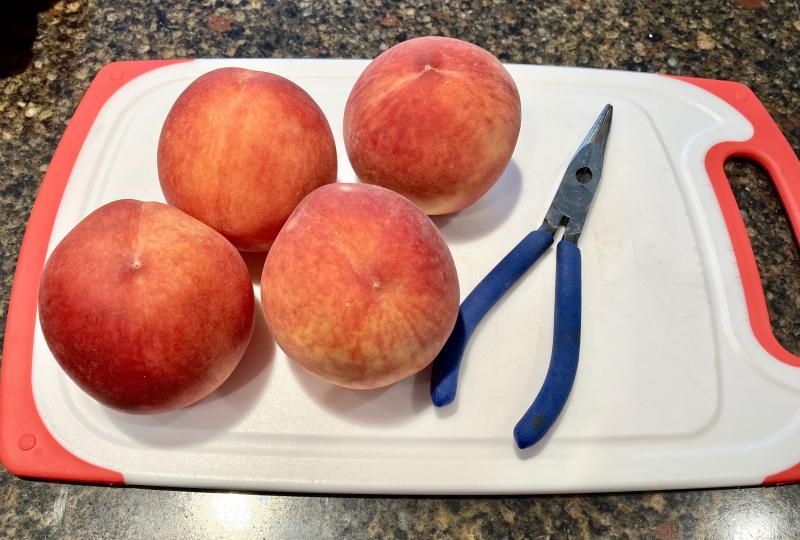Share:
Make the most of peach season
July 29, 2022
My friend, Marie is a fabulous cook and often the source of clever recipes and techniques. Last week, she forwarded an article from bon appétit describing a novel way to remove the pit from a peach with needle-nose pliers. Of course, almost every toolbox has one of these, but likely not clean enough to use in the kitchen on food. No worries, imbedded in the article was a pop-up ad from Amazon, listing 5-inch pliers for just eleven dollars.
Jack’s toolbox had pliers that matched the version in the advertisement, so I went into deep-clean mode to get them ready for a culinary application. The instructions were quite simple to follow: open the pliers about the width of a peach pit; insert the ends into the flesh at the top of the peach on either side of the stem; squeeze slightly to grab the pit; twist, if needed and pull.
For someone who had pitted countless peaches by halving and slicing and losing lots of juice to separate the pit from the flesh, this was the proverbial game-changer. Whether clingstone or freestone, the pit is easily extracted, leaving the juicy flesh ready to slice or dice for the recipe at hand. This is especially helpful when you want uniform slices for a pie or perfect quarters to grill.
Although peaches have long been a locally grown crop, they certainly aren’t native to Delaware. Both peaches and nectarines (smooth-skinned cousins to fuzzy-coated peaches) originated in China and traveled the Silk Road to Persia, from where its botanical name derived (prunus persica). Crossword puzzle fans already know that peaches, plums and apricots are drupes, stone fruits with a single seed, not pomes like the multi-seeded apples and pears.
The original settlers in Delaware didn’t revere peaches the way we do today. The wild fruit was typically fed to pigs or distilled into brandy. It wasn’t until 1832, when Isaac Reeves planted thirty acres of budded stock, which he soon expanded into hundreds of acres, becoming Delaware’s first commercial peach farmer. Before long, large peach orchards were located in all three counties of the state.
Processing plants were built to can or evaporate (dry) the peaches, as well as turn them into syrup. By 1875, Delaware’s crop totaled six million baskets, a number that quickly declined when stock in the orchard contracted “peach yellows,” a fatal disease. By the mid-1900s, local farmers once again began to cultivate peaches, ever watchful of the risks from disease, pests and unseasonable cold snaps. Today, we see close to two million pounds of peaches produced in Delaware annually.
The familiar names of Bennett Orchards, T.S. Smith & Sons, and Fifer Orchards are found for both u-pick experiences on their farms and fresh fruit offered at the various farmers markets. Even the large-scale supermarkets understand the appeal of locally-sourced produce, tagging the price signs with “local” stickers to encourage sales. I’ve included two recipes, one from Bennett Orchards for a sweet-and-sharp caprese salad and the other for a sweet-and-sour sauce called a gastrique, delicious over grilled meat, chicken or fish.
Peach Caprese Salad*
3 ripe peaches
2 medium heirloom tomatoes
2 medium heirloom tomatoes
1/2 lb mozzarella cheese
5 fresh basil leaves
2 T Balsamic vinegar
2 T fresh lemon juice
1 T Dijon mustard
1 T honey
1 minced shallot
2 T Balsamic vinegar
2 T fresh lemon juice
1 T Dijon mustard
1 T honey
1 minced shallot
3/4 t salt
1/4 t pepper
1/4 C olive oil
1/4 t pepper
1/4 C olive oil
Pit the peaches and slice into rounds. Core the tomatoes and slice into rounds. Slice the mozzarella into rounds. Arrange slices on a serving platter, alternating peaches, tomatoes and cheese. Chop the basil and scatter over the platter. Whisk together remaining ingredients until emulsified. Drizzle over salad. Yield: 4 servings. *Adapted from Bennett Orchards.
Peach Gastrique
2 T butter
1 minced shallot
1 T grated ginger
2 T sugar
2 C peeled, diced peaches
3 T white wine
3 T rice wine vinegar
1/4 t paprika
salt, to taste
Melt butter in a saucepan over medium. Stir in shallot and ginger, cook for 2 minutes, stirring often. Add remaining ingredients, increase heat and bring just to a boil. Reduce to low and simmer for 20 minutes, stirring occasionally. Once the mixture is thickened and syrupy, transfer to a blender or use an immersion blender to puree until smooth. Yield: 1 1/2 cups. Serve over grilled pork, beef, chicken or fish.
After publishing last week’s column about zucchini, I received an email from Feffie Barnhill sharing one of her family’s favorite summer recipes:
Zucchini Casserole
1 t soft butter
3 sliced zucchini
1 sliced Vidalia onion
2 lbs peeled tomatoes*
1/3 lb sliced Provolone cheese
Preheat oven to 350 F. Butter the insides of a casserole dish. Arrange zucchini slices across the bottom; top with sliced onion. Cover with tomatoes and then arrange cheese to cover the tomatoes completely. Cut a piece of foil to fit over the casserole and coat with nonstick cooking spray. Seal the dish with the coated side of foil on the cheese. Bake for 30 minutes. Remove the foil and bake until cheese starts to brown, another 10 to 15 minutes. *Use those tomatoes that aren’t pretty enough for a salad or substitute a drained 28-oz can of peeled tomatoes.






















































